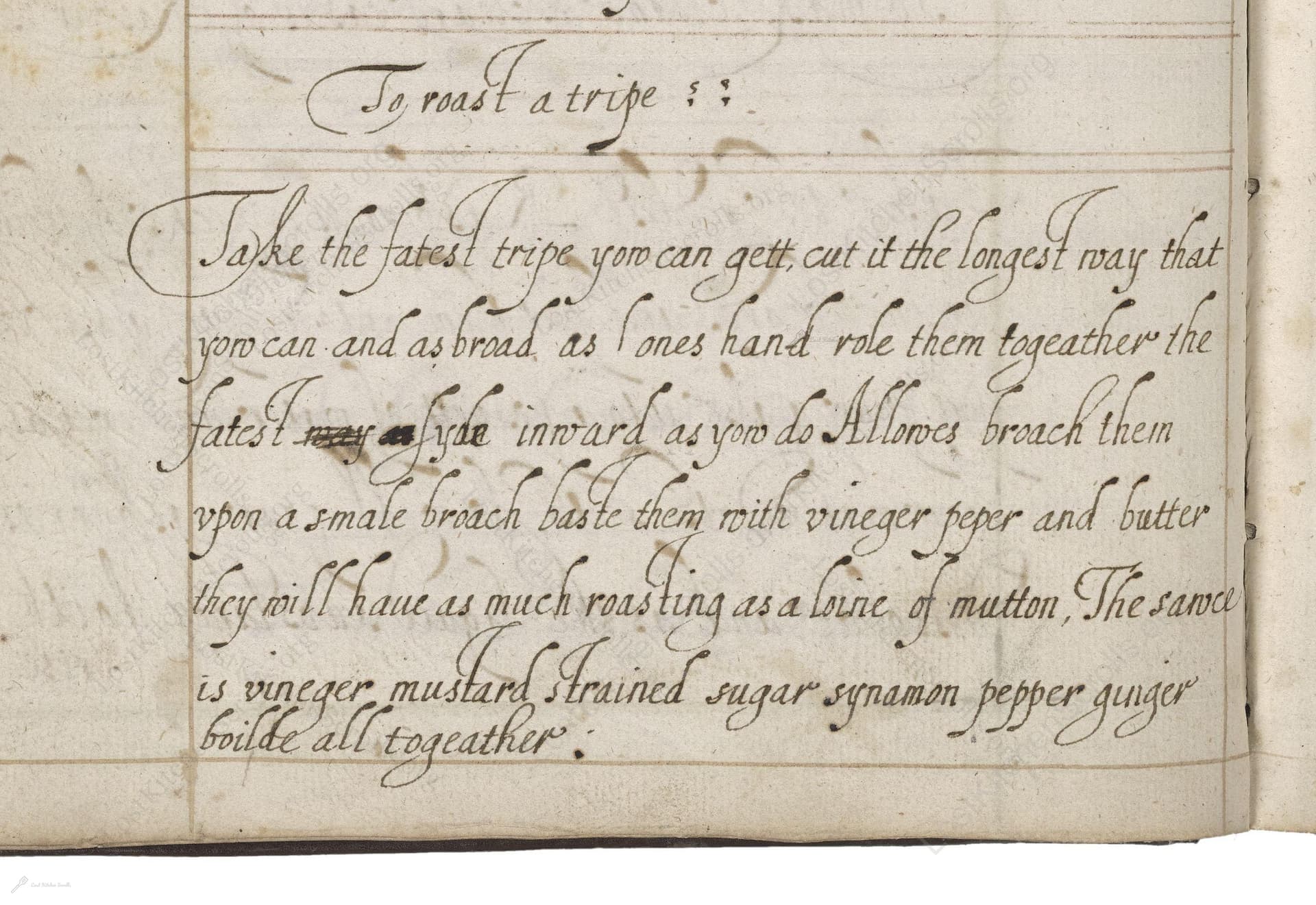To Roast A Tripe
From the treasured pages of Medicinal and cookery recipes by John King
Written by John King

To Roast A Tripe
"Take the fatest tripe you can gett, cut it the longest way that you can and as broad, as ones hand role them togeather the inward as you do Allowes broach them upon a smale broach baste them with vineger peper and butterr they will have as much roasting as a loine of mutton, The sawce is vineger mustard Strained sugar synnamon pepper ginger boilde all togeather:"
Note on the Original Text
The recipe is written in the colloquial, instructional voice of the time, using direct address ('Take the fatest tripe...'). It presumes readers are familiar with terms like 'Allowes' (rolled meats, often with a filling) and 'broach' (spit). Spelling was fluid: 'peper' for pepper, 'vineger' for vinegar, 'strayned' for strained, etc.—standardized spelling came later. Quantities are imprecise and depend on the cook's experience, and cook times are judged by analogy ('as much roasting as a loine of mutton'), assuming the reader's knowledge of kitchen routines.

Title
Medicinal and cookery recipes by John King (1675)
You can also click the book image above to peruse the original tome
Writer
John King
Era
1675
Publisher
Unknown
Background
A delightful journey into the kitchens of the 17th and early 18th centuries, this collection, attributed to John King, brims with time-honored recipes, culinary wisdom, and flavors that once graced historic tables.
Kindly made available by
Folger Shakespeare Library
This recipe comes from the English manuscript tradition in the late 17th or early 18th century, specifically tied to John King—a period alive with experimentation and rich, layered flavors in both elite and everyday kitchens. Offal such as tripe was commonly enjoyed, reflecting both nose-to-tail thrift and the aromatic, spiced palates of the Post-Restoration table. The combination of vinegar, butter, and warming spices is typical of the transitional English culinary style, which bridged medieval traditions and new influences from global trade. Such recipes were often written for literate, upper-middle class or gentry households, but tripe itself remained an ingredient enjoyed across social strata. The original instructions assume a kitchen equipped for roasting on a spit with open fire, making the dish both humble and luxurious in its time.

The tripe would have been boiled in a large copper or iron cauldron over an open hearth or brick stove. Once sliced and rolled, it was skewered on a 'broach'—an early spit or metal skewer—then roasted in front of the fire, likely in a turnspit or hanging oven if available. Basting brushes would be handmade from bundled herbs or cloth dipped into pans of butter and vinegar. The sauce would be simmered in a small earthenware or tinned pan and strained through muslin or fine sieve before serving in a sauce boat or dainty jug.
Prep Time
30 mins
Cook Time
2 hrs 30 mins
Servings
4
We've done our best to adapt this historical recipe for modern kitchens, but some details may still need refinement. We warmly welcome feedback from fellow cooks and culinary historians — your insights support the entire community!
Ingredients
- 2.2 lbs beef tripe (honeycomb if possible)
- Water and salt for parboiling
- 2 oz unsalted butter
- 2 tablespoons wine or cider vinegar
- Black pepper (to taste)
- 3.5 fl oz wine or cider vinegar (for the sauce)
- 1 tablespoon strong English mustard
- 2 tablespoons fine white sugar
- 1 teaspoon ground cinnamon
- 1 teaspoon ground black pepper
- 1 teaspoon ground ginger
Instructions
- Begin by sourcing beef tripe, preferably the thick, fatty honeycomb variety, about 2.2 lbs.
- Rinse and parboil the tripe in lightly salted water for 1-2 hours until tender.
- Once cool enough to handle, slice the tripe lengthwise into wide strips, approximately the width of your hand (2-3 inches).
- Roll each strip tightly, similar to how you might roll a scroll or, historically, as 'allows' (stuffed rolls).
- Skewer the rolled tripe onto metal or wooden skewers.
- Prepare a basting mixture by melting 2 oz butter with 2 tablespoons vinegar and a liberal grinding of black pepper.
- Roast the skewered tripe in a hot oven (400°F), basting regularly, for about 40-60 minutes until golden and crispy at the edges—roughly the time it takes to roast a small joint of lamb.
- For the sauce, combine 3.5 fl oz vinegar, 1 tablespoon English mustard, 2 tablespoons sugar, 1 teaspoon cinnamon, 1 teaspoon black pepper, and 1 teaspoon ground ginger in a small saucepan.
- Simmer gently, stirring well for 5-7 minutes.
- Strain the hot sauce before serving it alongside or drizzled over the roasted tripe.
Estimated Calories
350 per serving
Cooking Estimates
It takes about 1-2 hours to parboil the tripe until tender, and then an additional 40-60 minutes to roast it. Prepping the tripe, melting the butter, making the sauce, and getting everything ready takes around 30 minutes more. Each serving has about 350 calories, and the recipe makes 4 servings.
As noted above, we have made our best effort to translate and adapt this historical recipe for modern kitchens, taking into account ingredients nowadays, cooking techniques, measurements, and so on. However, historical recipes often contain assumptions that require interpretation.
We'd love for anyone to help improve these adaptations. Community contributions are highly welcome. If you have suggestions, corrections, or cooking tips based on your experience with this recipe, please share them below.
Join the Discussion
Rate This Recipe
Dietary Preference
Main Ingredients
Occasions

Den Bockfisch In Einer Fleisch Suppen Zu Kochen
This recipe hails from a German manuscript cookbook compiled in 1696, a time whe...

Die Grieß Nudlen Zumachen
This recipe comes from a rather mysterious manuscript cookbook, penned anonymous...

Ein Boudain
This recipe comes from an anonymous German-language manuscript cookbook from 169...

Ein Gesaltzen Citroni
This recipe, dating from 1696, comes from an extensive anonymous German cookbook...
Browse our complete collection of time-honored recipes



